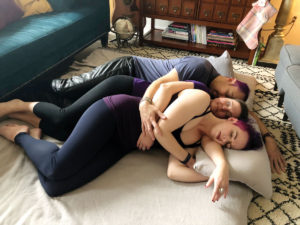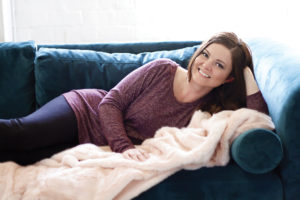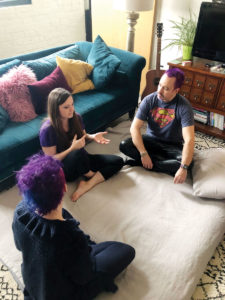Cuddling therapy
1/1/2020When intermingling with people and getting hugs isn’t enough, this therapeutic and platonic touch may be the answer.

Brandon Griffis spoons with Michelle White, center, and Christa Dickson. Photo by Melissa Walker
Michelle White was looking for a way to fulfill her need for personal connection and touch.
She had been single for several years and wanted affection.
“Intermingling with people and getting hugs just wasn’t enough as a single person,” she recalls.
She was introduced to the idea of cuddle therapy through an article posted on Facebook. She clicked the article, and the idea of cuddling
clicked for her.
“When I realized, looking back, that this was a thing that existed, that you could have a safe place to have platonic touch, I realized I
wouldn’t have felt some of the depression and isolation (I previously felt),” she explains.
White has owned Conscious Cuddles, a professional cuddling business, for more than two years. While White says the therapeutic, platonic touch she provides to her clients is about them, she still receives the reciprocal benefits.
“There are so many different needs: the single person, the divorced, the widowed, those who are struggling in their marriages,” White says.
The science behind cuddling
Numerous scientific studies have shown cuddling is good for humans. It can relieve pain, lower blood pressure, boost the immune system and reduce the risk of heart disease. A person’s brain releases a chemical called oxytocin, referred to as the “feel good hormone,” when the person cuddles, hugs, kisses, or has sex and orgasms.
Cuddling also has shown to lower cortisol levels. This is the stress hormone that makes people feel anxious.
The founders of Cuddlist, a national organization that trains individuals in therapeutic, platonic touch, says there’s more to it. Today’s society creates chronic social isolation and touch deprivation and has sexualized touch. Fewer people are touched, even by their parents, family members or friends, and, for some, their only experience with touch is sex, according to Cuddlist.
Cuddling is mutually beneficial and is like yoga, meditation or mindfulness in that it is healing and transformative.
Adam Lippin co-founded Cuddlist with Madelon Guinazzo, a consent expert. As a businessman, he also practiced yoga and meditated and saw the value in both. He realized there were a lot of lonely people, as well as those who were acting in ways that weren’t sexually healthy. He wanted to create a way that would supercharge connections between people.
As he was doing research about the idea of cuddling and going to cuddling parties, the reaction was mixed. Some told him it was crazy and equated it to prostitution.
Lippin countered: “It’s very easy to make fun of it and this and that, but if you haven’t had a date in 30 years, or you’re overweight, or on the autism spectrum, or you’ve lost a loved one, touch is missed.”
Others were instinctively into the idea.
“They say people who were touch-deprived and lonely wanted to be able to hug someone, but they couldn’t,” Lippin says, adding that he spoke to numerous mental health professionals.
White does not allow clients to watch television or be distracted during sessions. She wants them to be physically, mentally and emotionally present.
“That’s the beauty of it,” she says. “It seems in our culture that we are not very practiced at being in the moment. We do the same thing over and over. Here we are just really dropping down in our body and asking, ‘What would feel good to me right now?’ ”
White recently met with friends Brandon Griffis and Christa Dickson, both of Des Moines.
Griffis describes himself as highly affectionate but says, as a man, there’s a worry that it could send the wrong signals. He’s noticed among his group of friends more discussions about physical touch boundaries. He thinks it’s good for men to receive touch but also to be able to give it because many, himself included, view themselves in a caretaker role.
Dickson says she’s also affectionate with those who are open to it.
“It’s one of my primary love languages,” she says. “But in today’s day and age, touch can be interpreted differently in different ways.”
Cuddling isn’t just for adults. Studies also have shown that humans who have pets live longer, and those who snuggle with their pets report to be happier.
In Des Moines, babies in neonatal intensive care units have volunteer cuddlers who help provide human connection, which has been shown to help them thrive.
Professional vs. amateur cuddling

Michelle White, owner of Conscious Cuddles, is trained and certified in different cuddling methods. She works with individuals of different needs from the woman who has suffered trauma to the divorced or widowed man to the disabled person who seeks physical comfort. Photo submitted
White is certified through Cuddlist.com, an organization founded in 2015 to help people get meaningful human connection with trained, professional practitioners. Cuddlist requires its cuddlers to complete an online training course, have their performance with a client evaluated and approved, and follow a code of conduct.
White initially traveled to Colorado to meet with a cuddling trainer. She wanted in-person training to ensure she was learning firsthand. She then learned about Cuddlist and felt it was leading the way in ethical and professional cuddling and giving it more legitimacy. She completed their program but does ongoing training.
Cuddlist provides basic and advanced certification. Weekly, Guinazzo, the consent expert, hosts calls where practitioners can discuss specific issues such as body acceptance, trauma and aromatherapy.
Lippin says those cuddlers who are mothers oftentimes thrive the most because they know how to naturally nurture, and they have established physical boundaries. Massage therapists, doulas and those in the healing arts also have a natural ability to be a cuddler. Then there are individuals who have no experience but turn out to be fantastic at therapeutic touch, he says.
“It’s this deep connection to the work; they’re spiritual, empathic and they understand it,” he says. “They want to give back.”
Several other sites boast cuddling services and meet-ups to “spoon” and exchange platonic touch.

Michelle White, center, talks with friends Brandon Griffis and Christa Dickson, both of Des Moines, about what positions they like to be in while cuddling. Photo by Melissa Walker
Other sites such as Cuddle Comfort and Cuddle Companions show cuddlers located in central Iowa but require an account to contact the person.
Cuddle Companions offers cuddlers for a variety of purposes, according to its site, from those who help people heal, relieve loneliness and provide comfort to travel cuddlers who serve as a travel companion. Some cuddlers act as tour guides while others participate in hobbies such as playing video games or hiking.
To join Cuddle Comfort, a person must be affectionate to anyone, accepting to all, reliable with strong interpersonal and communication skills, and in agreement with the company’s contract, which includes platonic touch only. Cuddle Comfort also notifies its cuddlers that they are responsible for checking the credibility and authenticity of a client and allows them to carry and use non-lethal personal defense items subject to local laws and regulations.
For Cuddle Companies, the website says it guarantees its cuddlers are 100 percent real and are verified before they are approved and added to the website.
Although she’s listed on the Cuddlist website, White also has her own site for Conscious Cuddles. She initially advertised her business on Craigslist, but most of her clients have come from networking and word-of-mouth referrals. She’s also starting to get referrals from mental health and wellness professionals who see cuddling as a benefit to clients.
Cuddling session begins with initial screening, boundary discussion

Adam Lippin is the chief executive officer and co-founder of Cuddlist. Photo submitted
White screens each of her potential clients through email and a phone call consultation. They’ve usually exchanged multiple messages or calls before they meet in person. She greets prospective clients in a common area of her apartment building to further gauge the client. She’s had times when she’s turned down a client.
“I just really lean into how I’m feeling at the moment,” White says of whether or not to accept a client.
Once the client and White decide they’re a good fit, they come to her apartment and sign her agreement. Then they talk about personal boundaries: how they like to be touched, whether there is any type of cuddling that’s off limits, or places where they don’t want the person’s face or hands to go.
When White worked with friends Griffis and Dickson, they talked about positions they prefer during spooning, whether Griffis could touch and stroke White’s hair, where they would lay and where to rest their arms next to and on one another. White uses her bed, a mat and her couch as cuddling spots.
Dickson says her feelings about touch can change day to day. She’s an introvert and can get easily over-stimulated and doesn’t want anyone to touch her. She found her time being spooned by White as healing and comforting. White said she could feel that same vibe from Dickson.
Griffis says there is an element of learning to let go and go with it during cuddling sessions.
White says that’s why it’s important for both she and the client to continually communicate with each other throughout the session.
“So much of it is about verbal communication,” she explains. “The most important agreement is that we promise we won’t tolerate doing anything we don’t want. This is a space where, as long as we are within our agreement, there’s nothing you can do wrong because we’re asking and checking in with each other. It’s really empowering.”
Des Moines residents use cuddling as therapy, comfort
White says her close work with her clients has made her do her own bit of self-reflection.
“I’m a really big believer in we get back what we put out,” she continues. “My intentions are so clear with the people I’m wanting to work with that I’m really so fortunate I attract the people who want to do the work of having their ends met in a healthy way.”
Most of her repeat clients are men, age 30 and older.
Initially, Lippin says Cuddlist’s target market was men ages 50 to 70 who were in a loveless marriage, divorced or had health problems.
That’s changed.
Industry-wide, both White and Lippin with Cuddlist say more and more women are becoming interested in cuddling. Lippin says many people are using cuddle therapy as part of their recovery, whether it’s the stressed-out college student or the veteran with post-traumatic stress disorder.
With each client, White sets up a plan with a determined number of sessions and learns the client’s goals. Some have emotional goals. Others are trying to establish physical boundaries. One woman has experienced trauma and is trying to rebuild her ability to be in close proximity with a man.
In the case of one 30-year-old Des Moines man who asked not to be identified, he started seeking platonic touch at the suggestion of his therapist.
“As a person with a disability, oftentimes the way we encounter touch is highly medicalized and linked to trauma and not a great experience,” the man says. “This was a way for me to recontextualize that and address some of my lingering worries about touch.”
The man also was looking for someone he could trust and would align with his values. After he met White and talked to her about her services, he decided to hire her for one session a month.
“It’s been a really wonderful supplement to the mental health services I receive,” he says.
The man acknowledges there are some misconceptions about cuddling sessions. Professional cuddling sites specifically prohibit any nudity, hands under undergarments, kissing, fondling or other sexual behavior.
“It’s very platonic. There’s nothing I would be embarrassed for people to see,” he says. “I don’t think anybody would see it and confuse it for anything other than what it is. It’s completely platonic and sexless in a way that I think makes everybody feel comfortable.”
The man says he thinks cuddling and platonic touch help to dispel the hyper-sexuality of American culture in which any kind of touch between a man and a woman is looked at as sexual. For himself, he says physical touch has helped with anxiety and overall touch including learning how to ask others for a hug.
“People with disabilities, our bodies are treated as taboo,” he says. “Whether people are scared to hurt us or touch us, it’s a little bit of everything. That’s a disconnect. There’s a deficit of affection and physical intimacy.”
Some clients meet with White for an hour, others for two. Overall, the number of sessions ranges from 10 to 17.
During a session, White will talk with clients if they want. Sometimes people are quiet. She describes herself as a safe space for them to talk about anything. She shares about herself to a certain level because she believes a lack of personal intimacy is missing from today’s culture. She describes her relationship with her clients as a friendship.
“Every single human being needs touched,” White says. “There’s no one that it doesn’t really reach.” ♦




















